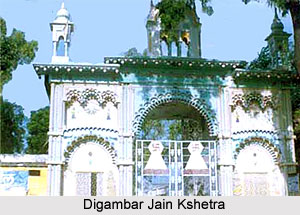 Shri Digambar Jain Kshetra located in Banpur in the state of Uttar Pradesh. It is an Atishaya Kshetra i.e. Place of Miracle. There are many temples located here that are dedicated to Lord Shantinath and Lord Mahavira.
Shri Digambar Jain Kshetra located in Banpur in the state of Uttar Pradesh. It is an Atishaya Kshetra i.e. Place of Miracle. There are many temples located here that are dedicated to Lord Shantinath and Lord Mahavira.
History of Digambar Jain Kshetra
According to history of Digambara Jain Kshetra, Banpur served as the capital of Banasura the king of demons. Banpur is now adorned with many Jain temples that are approximately more than 1000 years old. Banpur`s king Mardan Sing was with Rani Lakshmi Bai. The queen was a great warrior who fought against the English Empire in the Indian freedom struggle in the year 1857.
Temple of Digambar Jain Kshetra
There are five big ancient temples located here at Banpur. It is almost 200 X 280 feet in size. The main temple here is dedicated to Lord Shantinath. It is a magnificent idol that is 18 feet height. It is seen in a standing posture. The second temple houses the idol of Lord Mahavira that is almost 1000 years old. There are many other idols installed here. A beautiful idol of Lord Shantinath can be seen here. The idol is 18 feet in height and has been installed in V.S. 1001. Two standing idols of Lord Kunthunath and Lord Aranath 7 feet in height are built on both sides of Shantinath. A Sahastrakoot Chaityalaya that ahs been constructed before 10th century A.D is located here. It is a small temple made of single stone. It has been magnificently carved with 1008 idols.
The Temple of Digambar Jain Kshetra is surrounded by scenic beauty that mesmerises the pilgrims. A festival is also organized every year in the beginning of March since last 30 years. A free Eye Care Camp is also organized here every year for the last 22 years. It has provisions for dharamshalas or rest houses for the pilgrims.
The Temple of Digambar Jain Kshetra is well connected to road and rail. Bus, Taxi or Jeeps are easily available from Lalitpur, Maharoni and Teekamgarh every time. The nearest railway stations are located at Lalitpur at a distance of 32 km and Jhansi at a distance of 107 km.




















